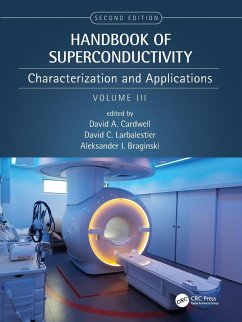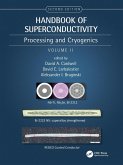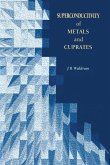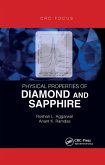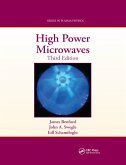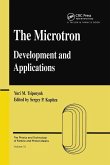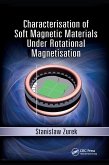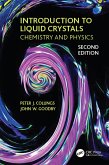Handbook of Superconductivity
Characterization and Applications, Volume Three
Herausgeber: Cardwell, David A; Braginski, Aleksander; Larbalestier, David C
Handbook of Superconductivity
Characterization and Applications, Volume Three
Herausgeber: Cardwell, David A; Braginski, Aleksander; Larbalestier, David C
- Broschiertes Buch
- Merkliste
- Auf die Merkliste
- Bewerten Bewerten
- Teilen
- Produkt teilen
- Produkterinnerung
- Produkterinnerung
This is the last of three volumes of the extensively revised and updated second edition of the Handbook of Superconductivity. The past twenty years have seen rapid progress in superconducting materials, which exhibit one of the most remarkable physical states of matter ever to be discovered
Andere Kunden interessierten sich auch für
![Handbook of Superconductivity Handbook of Superconductivity]() Handbook of Superconductivity62,99 €
Handbook of Superconductivity62,99 €![Superconductivity of Metals and Cuprates Superconductivity of Metals and Cuprates]() J R WaldramSuperconductivity of Metals and Cuprates165,99 €
J R WaldramSuperconductivity of Metals and Cuprates165,99 €![Physical Properties of Diamond and Sapphire Physical Properties of Diamond and Sapphire]() Roshan L AggarwalPhysical Properties of Diamond and Sapphire30,99 €
Roshan L AggarwalPhysical Properties of Diamond and Sapphire30,99 €![High Power Microwaves High Power Microwaves]() James BenfordHigh Power Microwaves65,99 €
James BenfordHigh Power Microwaves65,99 €![Microtron Microtron]() Yuri M TsipenyukMicrotron83,99 €
Yuri M TsipenyukMicrotron83,99 €![Characterisation of Soft Magnetic Materials Under Rotational Magnetisation Characterisation of Soft Magnetic Materials Under Rotational Magnetisation]() Stanislaw ZurekCharacterisation of Soft Magnetic Materials Under Rotational Magnetisation83,99 €
Stanislaw ZurekCharacterisation of Soft Magnetic Materials Under Rotational Magnetisation83,99 €![Introduction to Liquid Crystals Introduction to Liquid Crystals]() Peter J CollingsIntroduction to Liquid Crystals91,99 €
Peter J CollingsIntroduction to Liquid Crystals91,99 €-
-
-
This is the last of three volumes of the extensively revised and updated second edition of the Handbook of Superconductivity. The past twenty years have seen rapid progress in superconducting materials, which exhibit one of the most remarkable physical states of matter ever to be discovered
Hinweis: Dieser Artikel kann nur an eine deutsche Lieferadresse ausgeliefert werden.
Hinweis: Dieser Artikel kann nur an eine deutsche Lieferadresse ausgeliefert werden.
Produktdetails
- Produktdetails
- Verlag: CRC Press
- 2nd edition
- Seitenzahl: 858
- Erscheinungstermin: 12. März 2025
- Englisch
- Abmessung: 279mm x 210mm x 44mm
- Gewicht: 1941g
- ISBN-13: 9780367689209
- ISBN-10: 0367689200
- Artikelnr.: 73121887
- Herstellerkennzeichnung
- Libri GmbH
- Europaallee 1
- 36244 Bad Hersfeld
- gpsr@libri.de
- Verlag: CRC Press
- 2nd edition
- Seitenzahl: 858
- Erscheinungstermin: 12. März 2025
- Englisch
- Abmessung: 279mm x 210mm x 44mm
- Gewicht: 1941g
- ISBN-13: 9780367689209
- ISBN-10: 0367689200
- Artikelnr.: 73121887
- Herstellerkennzeichnung
- Libri GmbH
- Europaallee 1
- 36244 Bad Hersfeld
- gpsr@libri.de
Foreword. Preface. Acknowledgements. Editors-in-Chief. Contributors. Part G
Characterization and Modelling Techniques. G1 Introduction to Section G1:
Structure/Microstructure. G1.1 X-Ray Studies: Chemical Crystallography.
G1.2 X-Ray Studies: Phase Transformations and Microstructure Changes. G1.3
Transmission Electron Microscopy. G1.4 An Introduction to Digital Image
Analysis of Superconductors. G1.5 Optical Microscopy. G1.6 Neutron
Techniques: Flux-Line Lattice. G2 Introduction to Section G2: Measurement
and Interpretation of Electromagnetic Properties. G2.1 Electromagnetic
Properties of Superconductors. G2.2 Numerical Models of the Electromagnetic
Behavior of Superconductors. G2.3 DC Transport Critical Currents. G2.4
Characterisation of the Transport Critical Current Density for Conductor
Applications. G2.5 Magnetic Measurements of Critical Current Density,
Pinning, and Flux Creep. G2.6 AC Susceptibility. G2.7 AC Losses in
Superconducting Materials, Wires, and Tapes. G2.8 Characterization of
Superconductor Magnetic Properties in Crossed Magnetic Fields. G2.9
Microwave Impedance. G2.10 Local Probes of Magnetic Field Distribution.
G2.11 Some Unusual and Systematic Properties of Hole-Doped Cuprates in the
Normal and Superconducting States. G3 Introduction to Section G3: Thermal,
Mechanical, and Other Properties. G3.1 Thermal Properties: Specific Heat.
G3.2 Thermal Properties: Thermal Conductivity. G3.3 Thermal Properties:
Thermal Expansion. G3.4 Mechanical Properties. G3.5 Magneto-Optical
Characterization Techniques. Part H Applications. H1 Introduction to Large
Scale Applications. H1.1 Electromagnet Fundamentals. H1.2 Superconducting
Magnet Design. H1.3 MRI Magnets. H1.4 High-Temperature Superconducting
Current Leads. H1.5 Cables. H1.6 AC and DC Power Transmission. H1.7
Fault-Current Limiters. H1.8 Energy Storage. H1.9 Transformers. H1.10
Electrical Machines Using HTS Conductors. H1.11 Electrical Machines Using
Bulk HTS. H1.12 Homopolar Motors. H1.13 Magnetic Separation. H1.14
Superconducting Radiofrequency Cavities. H2 Introduction to Section H2:
High-Frequency Devices. H2.1 Microwave Resonators and Filters. H2.2
Transmission Lines. H2.3 Antennae. H3 Introduction to Section H3: Josephson
Junction Devices. H3.1 Josephson Effects. H3.2 SQUIDs. H3.3 Biomagnetism.
H3.4 Nondestructive Evaluation. H3.5 Digital Electronics. H3.6
Superconducting Analog-to-Digital Converters. H3.7 Superconducting Qubits.
H4 Introduction to Radiation and Particle Detectors that Use
Superconductivity. H4.1 Superconducting Tunnel Junction Radiation
Detectors. H4.2 Transition-Edge Sensors. H4.3 Superconducting Materials for
Microwave Kinetic Inductance Detectors. H4.4 Metallic Magnetic
Calorimeters. H4.5 Optical Detectors and Sensors. H4.6 Low-Noise
Superconducting Mixers for the Terahertz Frequency Range. H4.7
Applications: Metrology. Glossary. Index.
Characterization and Modelling Techniques. G1 Introduction to Section G1:
Structure/Microstructure. G1.1 X-Ray Studies: Chemical Crystallography.
G1.2 X-Ray Studies: Phase Transformations and Microstructure Changes. G1.3
Transmission Electron Microscopy. G1.4 An Introduction to Digital Image
Analysis of Superconductors. G1.5 Optical Microscopy. G1.6 Neutron
Techniques: Flux-Line Lattice. G2 Introduction to Section G2: Measurement
and Interpretation of Electromagnetic Properties. G2.1 Electromagnetic
Properties of Superconductors. G2.2 Numerical Models of the Electromagnetic
Behavior of Superconductors. G2.3 DC Transport Critical Currents. G2.4
Characterisation of the Transport Critical Current Density for Conductor
Applications. G2.5 Magnetic Measurements of Critical Current Density,
Pinning, and Flux Creep. G2.6 AC Susceptibility. G2.7 AC Losses in
Superconducting Materials, Wires, and Tapes. G2.8 Characterization of
Superconductor Magnetic Properties in Crossed Magnetic Fields. G2.9
Microwave Impedance. G2.10 Local Probes of Magnetic Field Distribution.
G2.11 Some Unusual and Systematic Properties of Hole-Doped Cuprates in the
Normal and Superconducting States. G3 Introduction to Section G3: Thermal,
Mechanical, and Other Properties. G3.1 Thermal Properties: Specific Heat.
G3.2 Thermal Properties: Thermal Conductivity. G3.3 Thermal Properties:
Thermal Expansion. G3.4 Mechanical Properties. G3.5 Magneto-Optical
Characterization Techniques. Part H Applications. H1 Introduction to Large
Scale Applications. H1.1 Electromagnet Fundamentals. H1.2 Superconducting
Magnet Design. H1.3 MRI Magnets. H1.4 High-Temperature Superconducting
Current Leads. H1.5 Cables. H1.6 AC and DC Power Transmission. H1.7
Fault-Current Limiters. H1.8 Energy Storage. H1.9 Transformers. H1.10
Electrical Machines Using HTS Conductors. H1.11 Electrical Machines Using
Bulk HTS. H1.12 Homopolar Motors. H1.13 Magnetic Separation. H1.14
Superconducting Radiofrequency Cavities. H2 Introduction to Section H2:
High-Frequency Devices. H2.1 Microwave Resonators and Filters. H2.2
Transmission Lines. H2.3 Antennae. H3 Introduction to Section H3: Josephson
Junction Devices. H3.1 Josephson Effects. H3.2 SQUIDs. H3.3 Biomagnetism.
H3.4 Nondestructive Evaluation. H3.5 Digital Electronics. H3.6
Superconducting Analog-to-Digital Converters. H3.7 Superconducting Qubits.
H4 Introduction to Radiation and Particle Detectors that Use
Superconductivity. H4.1 Superconducting Tunnel Junction Radiation
Detectors. H4.2 Transition-Edge Sensors. H4.3 Superconducting Materials for
Microwave Kinetic Inductance Detectors. H4.4 Metallic Magnetic
Calorimeters. H4.5 Optical Detectors and Sensors. H4.6 Low-Noise
Superconducting Mixers for the Terahertz Frequency Range. H4.7
Applications: Metrology. Glossary. Index.
Foreword. Preface. Acknowledgements. Editors-in-Chief. Contributors. Part G
Characterization and Modelling Techniques. G1 Introduction to Section G1:
Structure/Microstructure. G1.1 X-Ray Studies: Chemical Crystallography.
G1.2 X-Ray Studies: Phase Transformations and Microstructure Changes. G1.3
Transmission Electron Microscopy. G1.4 An Introduction to Digital Image
Analysis of Superconductors. G1.5 Optical Microscopy. G1.6 Neutron
Techniques: Flux-Line Lattice. G2 Introduction to Section G2: Measurement
and Interpretation of Electromagnetic Properties. G2.1 Electromagnetic
Properties of Superconductors. G2.2 Numerical Models of the Electromagnetic
Behavior of Superconductors. G2.3 DC Transport Critical Currents. G2.4
Characterisation of the Transport Critical Current Density for Conductor
Applications. G2.5 Magnetic Measurements of Critical Current Density,
Pinning, and Flux Creep. G2.6 AC Susceptibility. G2.7 AC Losses in
Superconducting Materials, Wires, and Tapes. G2.8 Characterization of
Superconductor Magnetic Properties in Crossed Magnetic Fields. G2.9
Microwave Impedance. G2.10 Local Probes of Magnetic Field Distribution.
G2.11 Some Unusual and Systematic Properties of Hole-Doped Cuprates in the
Normal and Superconducting States. G3 Introduction to Section G3: Thermal,
Mechanical, and Other Properties. G3.1 Thermal Properties: Specific Heat.
G3.2 Thermal Properties: Thermal Conductivity. G3.3 Thermal Properties:
Thermal Expansion. G3.4 Mechanical Properties. G3.5 Magneto-Optical
Characterization Techniques. Part H Applications. H1 Introduction to Large
Scale Applications. H1.1 Electromagnet Fundamentals. H1.2 Superconducting
Magnet Design. H1.3 MRI Magnets. H1.4 High-Temperature Superconducting
Current Leads. H1.5 Cables. H1.6 AC and DC Power Transmission. H1.7
Fault-Current Limiters. H1.8 Energy Storage. H1.9 Transformers. H1.10
Electrical Machines Using HTS Conductors. H1.11 Electrical Machines Using
Bulk HTS. H1.12 Homopolar Motors. H1.13 Magnetic Separation. H1.14
Superconducting Radiofrequency Cavities. H2 Introduction to Section H2:
High-Frequency Devices. H2.1 Microwave Resonators and Filters. H2.2
Transmission Lines. H2.3 Antennae. H3 Introduction to Section H3: Josephson
Junction Devices. H3.1 Josephson Effects. H3.2 SQUIDs. H3.3 Biomagnetism.
H3.4 Nondestructive Evaluation. H3.5 Digital Electronics. H3.6
Superconducting Analog-to-Digital Converters. H3.7 Superconducting Qubits.
H4 Introduction to Radiation and Particle Detectors that Use
Superconductivity. H4.1 Superconducting Tunnel Junction Radiation
Detectors. H4.2 Transition-Edge Sensors. H4.3 Superconducting Materials for
Microwave Kinetic Inductance Detectors. H4.4 Metallic Magnetic
Calorimeters. H4.5 Optical Detectors and Sensors. H4.6 Low-Noise
Superconducting Mixers for the Terahertz Frequency Range. H4.7
Applications: Metrology. Glossary. Index.
Characterization and Modelling Techniques. G1 Introduction to Section G1:
Structure/Microstructure. G1.1 X-Ray Studies: Chemical Crystallography.
G1.2 X-Ray Studies: Phase Transformations and Microstructure Changes. G1.3
Transmission Electron Microscopy. G1.4 An Introduction to Digital Image
Analysis of Superconductors. G1.5 Optical Microscopy. G1.6 Neutron
Techniques: Flux-Line Lattice. G2 Introduction to Section G2: Measurement
and Interpretation of Electromagnetic Properties. G2.1 Electromagnetic
Properties of Superconductors. G2.2 Numerical Models of the Electromagnetic
Behavior of Superconductors. G2.3 DC Transport Critical Currents. G2.4
Characterisation of the Transport Critical Current Density for Conductor
Applications. G2.5 Magnetic Measurements of Critical Current Density,
Pinning, and Flux Creep. G2.6 AC Susceptibility. G2.7 AC Losses in
Superconducting Materials, Wires, and Tapes. G2.8 Characterization of
Superconductor Magnetic Properties in Crossed Magnetic Fields. G2.9
Microwave Impedance. G2.10 Local Probes of Magnetic Field Distribution.
G2.11 Some Unusual and Systematic Properties of Hole-Doped Cuprates in the
Normal and Superconducting States. G3 Introduction to Section G3: Thermal,
Mechanical, and Other Properties. G3.1 Thermal Properties: Specific Heat.
G3.2 Thermal Properties: Thermal Conductivity. G3.3 Thermal Properties:
Thermal Expansion. G3.4 Mechanical Properties. G3.5 Magneto-Optical
Characterization Techniques. Part H Applications. H1 Introduction to Large
Scale Applications. H1.1 Electromagnet Fundamentals. H1.2 Superconducting
Magnet Design. H1.3 MRI Magnets. H1.4 High-Temperature Superconducting
Current Leads. H1.5 Cables. H1.6 AC and DC Power Transmission. H1.7
Fault-Current Limiters. H1.8 Energy Storage. H1.9 Transformers. H1.10
Electrical Machines Using HTS Conductors. H1.11 Electrical Machines Using
Bulk HTS. H1.12 Homopolar Motors. H1.13 Magnetic Separation. H1.14
Superconducting Radiofrequency Cavities. H2 Introduction to Section H2:
High-Frequency Devices. H2.1 Microwave Resonators and Filters. H2.2
Transmission Lines. H2.3 Antennae. H3 Introduction to Section H3: Josephson
Junction Devices. H3.1 Josephson Effects. H3.2 SQUIDs. H3.3 Biomagnetism.
H3.4 Nondestructive Evaluation. H3.5 Digital Electronics. H3.6
Superconducting Analog-to-Digital Converters. H3.7 Superconducting Qubits.
H4 Introduction to Radiation and Particle Detectors that Use
Superconductivity. H4.1 Superconducting Tunnel Junction Radiation
Detectors. H4.2 Transition-Edge Sensors. H4.3 Superconducting Materials for
Microwave Kinetic Inductance Detectors. H4.4 Metallic Magnetic
Calorimeters. H4.5 Optical Detectors and Sensors. H4.6 Low-Noise
Superconducting Mixers for the Terahertz Frequency Range. H4.7
Applications: Metrology. Glossary. Index.

